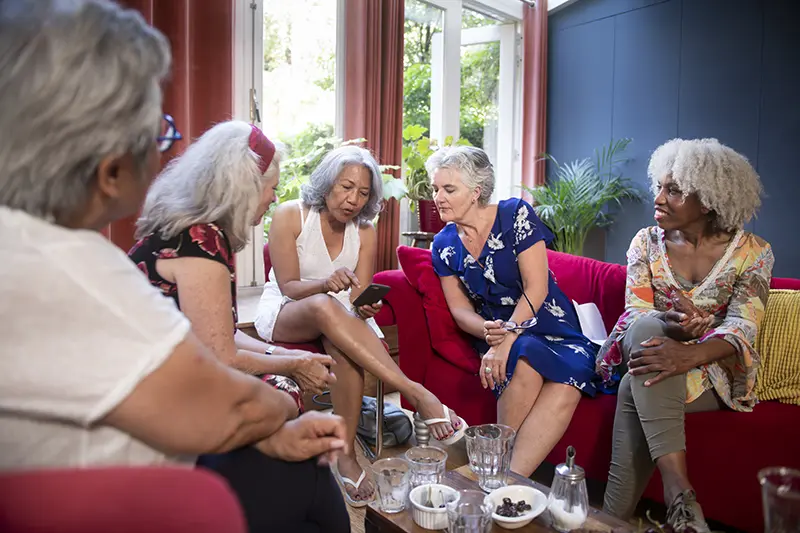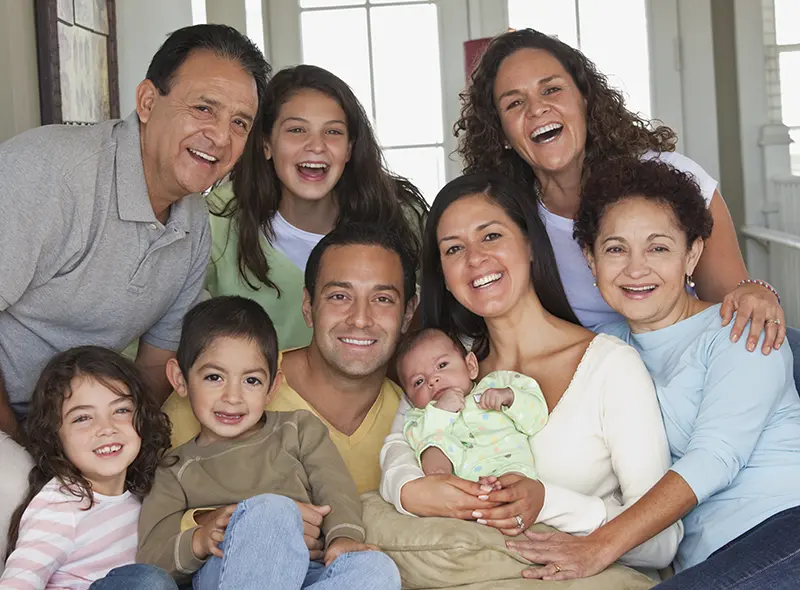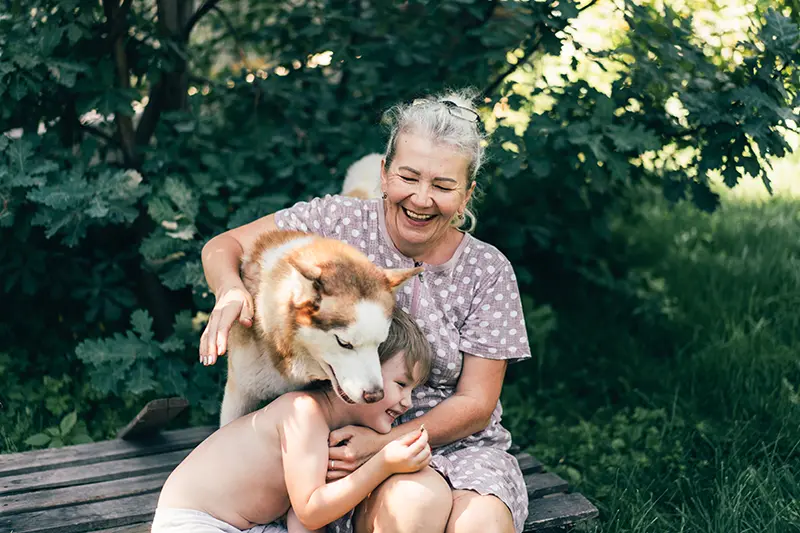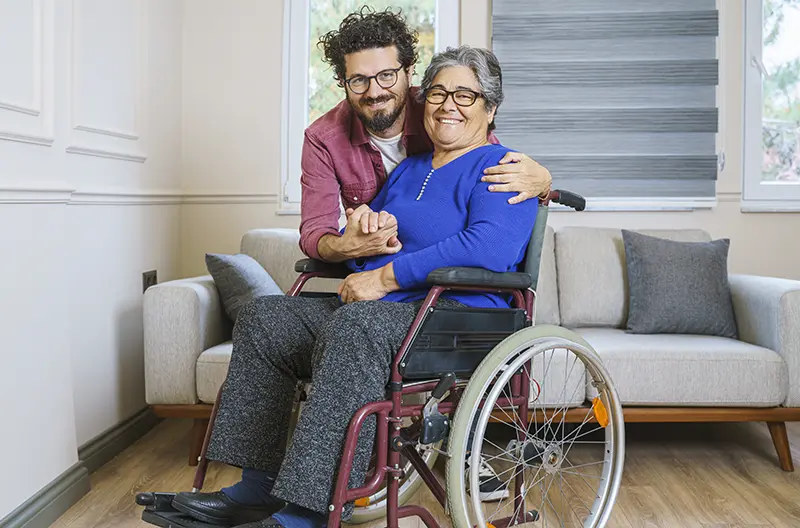Interdependence

The love and support of my family.
Female, 63, in response to being asked what contributes to her overall well-being1
- 60% Married; 64% of 50s, 63% of 60s, 53% of 70-plus
- 18% Divorced/Separated; 20% of 50s, 20% of 60s, 15% of 70-plus
- 10% Never Married; 14% of 50s, 10% of 60s, 6% of 70-plus
- 12% Widowed (18% women vs 6% men); 3% of 50s, 8% of 60s, 26% of 70-plus
- 79% are parents; 79% of 50s, 78% of 60s, 81% of 70-plus
- 9% are parents of children under 18 in their home; 20% of 50s, 4% of 60s, 2% of 70-plus
- 27% live with adult children; 41% of 50s, 24% of 60s, 15% of 70-plus
- 7% have a child in college; 14% of 50s, 4% of 60s, 1% of 70-plus
- 62% are grandparents; 43% of 50s, 63% of 60s, 78% of 70-plus
- 20% are caregivers to an adult loved one with health or functional needs
Source: Data on marital status, parent of children under 18 in home: 2022 American Community Survey (ACS PUMS), Prepared by AARP Research; Data on parent of child in college: Market/Release: Scarborough USA+ 2022 Release 2 Total (Jun 2021 - Nov 2022); Data on parents, living with adult child: MRI-Simmons USA Fall 2023 Report © 2023, MRI-Simmons; Data on grandparents: “Well-being and Social Connectedness Omni,” (August 2023) (Unpublished); Data on caregivers: Caregiving in the U.S., 2020.
Interdependence “embodies mutual reliance between individuals, offering synergistic benefits from the participation of both.”2 Everyone depends on others, others depend on us, and this reliance may take different forms as one moves through life’s stages. While older adults are both givers and receivers of support, the notion of interdependence is often under-explored when it comes to adults 50-plus, as the focus tends to be on loss of independence versus a lifelong balancing of independence and individuation and interdependence.3 Topics related to this include:
Support Networks

Adults 50-plus rely on their support networks for emotional support, company and companionship, joy and help in navigating life’s challenges.
Adults 50-plus may look to different relationships for different reasons. For instance, spouses are the most common source of emotional support and companionship, whereas children are the most common source of joy. (See Connections).
Who adults 50 and over rely on shifts throughout the life course and depends on personal circumstances.
For example, while spouses are the most common source of emotional support for adults 50 and over overall, friendships and children are the most important sources of emotional support for those who are divorced/separated or widowed.5 As such, as adults age, children become more central support figures.
Children are the most common source of emotional support for Black/African American adults; for White adults, spouses are (White adults are more likely to be married). Black adults are also more likely to look to extended family for emotional support.6
Solo agers, that is, adults who live alone and do not have significant others or children, are more likely to experience loneliness and feel socially isolated than other adults 50-plus. Fifty-five percent of solo agers report lacking companionship sometimes or often, compared to 31% of adults 50-plus overall.7
Adults 50-plus rely most on spouses, children and friends for emotional support, with the relationships one relies on shifting throughout the life course.
Who adults 50 and older rely on most for emotional support
Women 50-plus are more likely than men to rely on a variety of relationship types—children, friends, siblings—for emotional support, navigating life’s decisions and for quality time.
Men, on the other hand, are more likely to strongly depend on spouses (men 50 and older are more likely than women to be married). These data are indicative of women having more robust social networks outside of spousal relationships that could impact resiliency in the event of a disruption of a marriage or partnership and could be why women tend to fare better emotionally in widowhood. (See Connections).
Purpose

The support adults 50-plus provide to their family contributes deeply to their sense of purpose. Friends are a source of great purpose as well.
Older adults increasingly report with age that relationships with family and friends contribute greatly to their sense of purpose. Children and spouses are the most common drivers of purpose. Importantly, children continue to be a top source of purpose even as most have reached adulthood, suggesting that parents continue to associate their parenting role with their identity even as their children are grown. Friends are a top source of purpose for adults 50 and older who have never married. (See Connections).
With age, adults increasingly attribute their sense of purpose to their relationships with family and friends.
Extent to which family and friends contribute to sense of purpose
Adults 50-plus most commonly cite children and spouses as providers of purpose, with grandchildren a common source of purpose among grandparents.
Relationships that provide adults 50-plus with a sense of purpose
Older adults are critical givers of emotional support to their adult children and their parents.
One in five adults in their 50s still have children under the age of 18 at home; however, their role in providing emotional support does not stop there. Over seven in ten parents of adult children say their child(ren) rely on them for emotional support at least sometimes. This is especially true for mothers and parents ages 40-59. Further, of adults (of any age) with parents 65 and older, seven in ten say their parent relies on them at least sometimes for emotional support, with this especially true for adults 60-plus.
Older adults provide emotional support to adult children and parents.
Frequency in which parents of at least one grown child say their child(ren) rely on them for emotional support; Frequency in which adults with at least one parent 65-plus say their parent(s) rely on them for emotional support

Grandparents play vital support roles.
Almost four in ten (38%) grandparents say they play a daycare/babysitting role in their grandchildren’s lives. One in ten grandparents live with their grandchildren, and four percent of grandparents are primary caregivers of grandchildren.9
Beyond people, pets are also a strong source of purpose for older adults.
Pets are associated with providing older adults with a sense of purpose and companionship, relieving stress and anxiety, and increasing opportunities to get outside, exercise, socialize and meet people.10,11
Pets provide emotional support to solo agers, with over one-third (38%) of these adults owning a pet. Among solo agers in their fifties, 45% are pet owners, making them more likely to have a pet than their older counterparts.12
Adopting a pet has a significant impact on sense of purpose for retirees.
71%
of retirees who adopted a pet say adopting a pet had a significant impact on their sense of purpose.
Interdependent Decision-Making

For support in navigating life’s complex decisions, people 50-plus most commonly turn to spouses/partners; however, children become increasingly important to interdependent decision making with age.
Children are the most common source of decision-making support for those who are divorced/separated or widowed. Men, who are more likely to be married, overwhelmingly rely on spouses for support with complex decisions, whereas women are more likely than men to look to a variety of people. White adults 50-plus overwhelmingly look to spouses; Black adults are equally likely to look to spouses and children. Black and Hispanic adults are also slightly more likely to look to extended kin.
Adults with low incomes as well as adults who are not married are particularly likely to say they do not have anyone to rely on to navigate decisions (with over one in 10 members of these groups saying this).13
Spouses look to each other to navigate complex decisions, but children become more significant support people with age.
Relationships adults 50-plus rely on most to help navigate complex decisions
Financial Support

Older adults are critical providers of financial support.
Looking specifically at those ages 40-64, as of 2019, half of those with adult children over 24 had provided financial support to adult children in the last year. A third (32%) of those ages 40-64 with living parents had provided financial support to parents in the last year. Adults who provide this type of support are split in terms of whether their experience has led to financial strain.14
Adults in midlife or older financially support adult children and parents.
Among adults ages 40-64 with children age 25-plus or with living parents
Half of adults ages 40-64 who provide financial support report moderate to high financial strain as a result.
Among adults ages 40-64 who provide support to adult children and parents
Adults 50 and older most commonly report spousal relationships providing financial support, or not needing financial support at all.
With age, adults are increasingly likely to say children provide financial support. Notably, those with the least income are most likely to have no one to rely on for financial support.16
Adults 50-plus with low incomes are the least likely to have someone to rely on for financial support.
Relationships adults 50-plus rely on most for financial support
Long-Term Services and Supports (LTSS)
The need for LTSS progresses with age.
In 2018, 14 million adults in the United States needed long-term services and supports, more than half of whom were 65 years of age or older. One in 20 of those ages 50-64 are already in need of LTSS.18
Long-term support and services, along with the financial costs associated with needing them, weigh heavily on the minds of adults 50-plus.
Percent concerned with each of the following, among registered voters 50-plus
LTSS lacks accessibility because of high costs of care and lack of coverage.
As of 2019, annual costs for almost all the various types of LTSS care exceeded the median income for Medicare beneficiaries. Further, “the costs of one year of nursing facility care exceeded the median savings for Medicare beneficiaries in 2019 ($73,800), meaning over half of people on Medicare do not have sufficient savings to pay for one year of nursing facility care,” per KFF.20
LTSS are extremely expensive, and most are not covered by Medicare.
These costs “represent what people might be expected to pay if they did not qualify for Medicaid. (A small number of people have private long-term care insurance, which may help defray those costs.) Nursing facility costs were higher than the costs of other services but many people living outside of nursing facilities use multiple services simultaneously.”

Many have not had serious conversations about their future care needs with loved ones.
Fewer than half of adults ages 50-64 (45%) and just over half of adults 65 and older (52%) say they have ever had a serious conversation with a loved one about who will take care of them if they need help caring for themselves. Less than four in ten (37%) of those ages 50-64 and half (48%) of those 65-plus have had a serious conversation about how they will pay for health care and other support they need if they become seriously ill. Half (51%) of adults ages 50-64 and three in ten adults 65-plus are not too or not at all confident they will have the financial resources to pay for any care they need as they get older.21
Solo agers are more prone to needing ongoing support as they do not cohabitate with a spouse or children who can immediately help them when in need. However, four in five haven’t made any arrangements for the ongoing care they may need in the future.22
Family caregiving is a common experience for adults 50 and older.
About one in five adults 50-plus are caregivers to an adult loved one with health or functional needs. Ages 50-64 are the most prevalent caregiving ages, but caregiving remains common in older age.27
Across races and ethnicities, Hispanic and Black adults are more likely to engage in caregiving activities such as helping with home tasks, picking up prescriptions, and attending doctor’s appointments.28
Two in five adults 50-plus are caregivers.
Percent who are caregivers and age breakdown of caregivers
Love is a predominant emotion associated with caregiving.
Response to the open-ended question, “what three words come to mind when you hear the word “caregiving?” among adults 50 and older

For caregivers, positive emotions often coexist with feelings of isolation, stress, or strain.
Half of caregivers 50 or older feel their role as a caregiver gives them a sense of purpose or meaning in life. At the same time, nearly four in 10 (37%) caregivers 50-plus consider their caregiving situation to be highly emotionally stressful, while two in 10 (21%) feel alone.

That I’ll be healthy long enough and financially stable soon enough in order to take care of my partner.
Male, 50, in response to being asked what worries they have about getting older29
Caregivers also face significant financial hurdles.
On average, family caregivers 50 and older spend one-fifth (19%) of their income on caregiving activities, with household (30%) and medical (19%) costs making up the largest share of overall caregiver expenses.30
Key Takeaways
-
Interdependence is linked to greater longevity, with adults 50-plus being both givers and receivers of support.
-
Adults 50 and older mostly rely on spouses, children, and friends for emotional support, but these relationships evolve over time based on personal circumstances. Women are more likely than men to depend on a variety of relationship types for emotional support and decision-making. Robust social connections are related to resiliency, and a reason why women tend to fare better emotionally in widowhood.
-
Relationships with family and friends play a crucial role in providing a sense of purpose for older adults, particularly through connections with children and spouses. Hispanic adults, in particular, view family roles and relationships as central to their identities and prioritize the group’s well-being over individual needs.
-
Long-term services and supports (LTSS) are needed by many older adults, yet these resources are often inaccessible due to high costs and limited coverage. Further, many older adults struggle with the idea of being dependent on others and avoid necessary conversations about future care needs. Disassociating needing care from being a burden can help reduce associated stigmas.
-
Caregiving is common among adults over 50, with one in five providing care to an adult loved one. This role is particularly prevalent among those ages 50-64 and involves significant financial costs, often leading to feelings of isolation and stress. These feelings coexist with positive feelings like a sense of purpose, which Hispanic adults are especially likely to report experiencing—relating to their value of interdependence. Hispanic and Black adults are more likely to engage in caregiving activities, increasing the financial and emotional challenges they face regularly even while experiencing benefits. Common motivators are love and obligation.
See also:
For more information related to interdependence, see:
- The Lived Experience of Adults 50-plus: Connections
- The Lived Experience of Adults 50-plus: Independence and Autonomy
- The People Say : Caregiver Support
Sources
- Feedback Loop Research, AARP, June 2023 (Unpublished).
- “The Difference Between Codependency and Interdependence,” Adults, Family, Relationships, Strategies (Oct 3, 2023).
- Emily A. Largent, Justin Clapp, Jennifer S. Blumenthal-Barby, Christine Grady, Amy L. McGuire, Jason Karlawish, Joshua D. Grill, Shana D. Stites, Andrew Peterson, “Deciding with Others: Interdependent Decision-Making,” (December 20, 2022).
- R. Ng, HG Allore, and BR Levy, “Self-Acceptance and Interdependence Promote Longevity: Evidence From a 20-year Prospective Cohort Study,” International Journal of Environmental Research and Public Health, Vol. 17, no. 16 (Aug 18, 2020), doi: 10.3390/ijerph17165980. PMID: 32824658; PMCID: PMC7460297.
- AARP Research, “Well-being and Social Connectedness Omni,” (August 2023) (Unpublished). Omni conducted in English.
- AARP Research, Well-being and Social Connectedness Omni.
- Childs, Stephanie. Solo Agers: Attitudes and Experiences. Washington, DC: AARP Research, April 2023.
- Hearts and Minds of Hispanic Adults 50-plus Qualitative Research, AARP. Unpublished.
- David, Patty, and Brittne Nelson-Kakulla, Ph.D. 2018 Grandparents Today National Survey: General Population Report. Washington, DC: AARP Research, April 2019.
- Edward Jones, “Resilient Choices Trade-Offs, Adjustments, and Course Corrections to Thrive in Retirement,” (2023).
- Woman’s Best Friend: A Look Into Pet Ownership Among Gen X and Boomer Women, AARP. (Unpublished.)
- Childs. Solo Agers: Attitudes and Experiences.
- AARP Research, Well-being and Social Connectedness Omni.
- AARP Research, “Midlife Adults Providing Financial Support to Family Members,” (February 2020).
- “How America Pays for College 2023.” Sallie Mae.
- AARP Research, Well-being and Social Connectedness Omni.
- Edem Hado and Harriet Komisar, “Long-Term Services and Supports,” AARP Public Policy Institute (August 2019).
- Hado, Long-Term Services and Supports.
- “Medicaid 101” 2024. KFF. May 28, 2024; Priya Chidambaram and Alice Burns, “10 Things About Long-Term Services and Supports (LTSS),” (Sep 15, 2022).
- KFF analysis of Genworth 2021 Cost of Care Survey.
- Liz Hamel and Alex Montero, “The Affordability of Long-Term Care and Support Services: Findings from a KFF Survey,” (November 14, 2023).
- Childs. Solo Agers: Attitudes and Experiences.
- Innovation Unit, “The Power of Interdependence,” (September 13, 2017).
- “Celebrating Interdependence: Reframing the Eldercare Conversation - Aging Wisely.”
- Sonya Barsness, “Resurgence: Interdependence Day 2021,” Being Heard: The Voice of a Revisionary Gerontologist, (July 22, 2021).
- Judith S. Parnes, “Interdependence: Creating a Better Future for All of Us.”
- AARP Research, “Caregiving in the U.S., 2020,” (2020).
- Collage Group, Health And Wellness Study December 2022. (Not publicly available. Contact Collage Group for details.)
- Feedback Loop Research, AARP, June 2023. (Unpublished.)
- AARP Research, “AARP Research Insights on Caregiving,” (July 18, 2023).